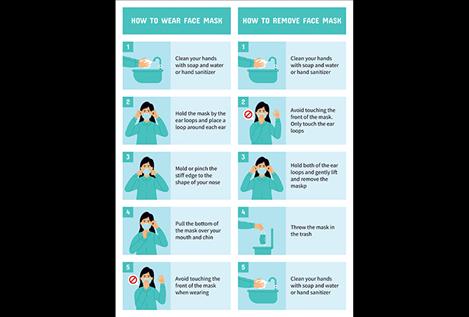COVID-19 safety protection strategy compares to race car driving
Hey savvy news reader! Thanks for choosing local.
You are now reading
1 of 3 free articles.
While out shopping in the grocery store, we have all seen examples of face coverings worn improperly, including those pulled down under the nose.
Greg Gould is the operations chief for the Lake County-Confederated Salish and Kootenai Tribes Unified Command Center. He said that wearing a mask under the nose is not any better than not wearing one at all. “A mask below your nose is absolutely useless,” he said.
As the number of novel coronavirus cases spike, wearing a mask has become important. Cloth face coverings are recommended as a simple barrier to help reduce the virus and prevent respiratory droplets from traveling into the air. Improperly wearing a mask does little to offer protection from respiratory droplets that can come from the nose as well as the mouth.
Gould offers several tips to ensure the proper and effective use of a face covering. He said people should wash their hands before putting on a face mask: “Make sure your hands are clean.” Before putting on a mask and immediately after removing the mask, people should wash their hands with soap and water, he said.
People should wear clean, breathable face masks. Gould said wearing the same mask without washing it could expose a person to contaminants.
After hand washing, the mask should be put on by holding it by the ear loops and slipping them on the ears. The mask should be pulled up so that it covers and conforms to the bridge of the nose, and then, it should be tugged down at the bottom so that it covers the chin. The mask should fit snugly against the face and avoid any gaps. It should not be so tight that it is difficult to breathe.
After the mask is on, it is important to avoid touching and fiddling with it until it is time to take it off. Before the mask is taken off, it is also important to do another round of hand washing. Remove the mask by grabbing the ear loops and pull the mask away from the face. The front of the mask could be contaminated with potentially infectious material, discard the mask immediately into the trash. If the mask is reusable, place the mask in a plastic bag or directly into the washing machine. Wash it in soapy water and dry on high heat. Remember to treat the mask like an infected surface after using it and be sure to wash your hands after handling it.
Many people remain skeptical about the health benefits of using face coverings and embracing recommendations to wear masks while out in the public. Gould said some people argue that wearing a mask isn’t 100 percent successful. “They are 100 percent correct,” he said. He continued: “The thing the public needs to keep in mind is that there is no magic bullet. It’s a combination of all the things we do in conjunction from social distancing, washing hands and wearing a mask that reduces the risk of coronavirus exposure and creates a safer situation for our community.”
Gould said the COVID-19 safety measures were similar to race car safety measures in that they both follow a multi-step approach.
“It’s kind of like driving in NASCAR and going 200 miles an hour and wearing just a helmet,” Gould said. He explained that NASCAR drivers depend on a number of things to protect them, including crumple zones, bucket seats and five-points harnesses to create a safe racing environment. The COVID-19 protection strategy is similar in that it also involves several safety measures that work better together, including face masks, hand washing and social distancing.
















